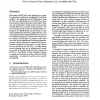Free Online Productivity Tools
i2Speak
i2Symbol
i2OCR
iTex2Img
iWeb2Print
iWeb2Shot
i2Type
iPdf2Split
iPdf2Merge
i2Bopomofo
i2Arabic
i2Style
i2Image
i2PDF
iLatex2Rtf
Sci2ools
VLDB
1990
ACM
1990
ACM
Performance Analysis of Disk Arrays under Failure
Disk arrays (RAID) have been proposed as a possible approach to solving the emerging I/O bottleneck problem. The performance of a RAID system when all disks are operational and the MTTF,,, (mean time to system failure) have been well studied. However, the performance of disk arrays in the presence of failed disks has not received much attention. The same techniques that provide the storage efficient redundancy of a RAID system can also result in a significant performance hit when a single disk fails. This is of importance since single disk failures are expected to be relatively frequent in a system with a large number of disks. In this paper we propose a new variation of the RAID organization that has significant advantages in both reducing the magnitude of the performance degradation when there is a single failure and can also reduce the MTTF,,,. We also discuss several strategies that can be implemented to speed the rebuild of the failed disk and thus increase the MTTF,,,. The effic...
Database | Disk Arrays | RAID | Single Disk | VLDB 1990 |
Related Content
| Added | 11 Aug 2010 |
| Updated | 11 Aug 2010 |
| Type | Conference |
| Year | 1990 |
| Where | VLDB |
| Authors | Richard R. Muntz, John C. S. Lui |
Comments (0)

